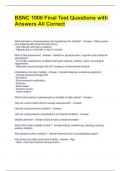BSNC 1000 Final Test Questions with
Answers All Correct
What warrants a comprehensive risk assessment for mobility? - Answer-- Older person
who presents with acute fall (with injury)
- Has difficulty with gait or balance
- Reports two or more falls in last 12 months
Risk of falls assessment - Answer-- Medial hx, physical exam, cognitive and functional
assessment
- Hx of falls, medications, problems with gait, balance, mobility, vision, neurological
impairments
- Reduced muscle strength with HR, footwear, environmental hazards
Interventions for poor mobility - Answer-- Assisted devices, protective equipment
- Clinical disease management
- Education
- Environmental modification
- Exercise
- Med review
- Nutrition review
- Vision referral
What is the impact of osteoporosis on mobility in older adults? - Answer-
How do nurses health clients manage osteoporosis? - Answer-
How do nurses promote mobility? - Answer-
How do nurses prevent complications of impaired mobility? - Answer-
Mobility definition - Answer-State of being mobile/moveable
What ADLS does mobility involve? - Answer-Eating, transferring, dressing, bathing,
walking, toileting
What systems effect mobility? - Answer-Nervous and musculoskeletal system
Risk factors for older adults and mobility - Answer-- Age
- Falls= more hip fractures among women
, - Stroke, head injury, illness, nutrition deficiencies
Assessment hx cues - Answer-- Pain with movements, mobility/balance impairment,
fatigue, falls, ADL changes
Primary Prevention for impaired mobility - Answer-- regular physical activity, nutrition,
body weight, rest, environment safer, lighting, footwear, vision impairment
Secondary prevention for impaired mobility - Answer-- Osteoporosis screening, fall
assessment, gait and balance assessment
Osteoporosis definition - Answer-- A systemic disorder characterized by low bone
density and micro-architectural deterioration
Non modifiable risks for osteoporosis - Answer-- Age, female genetics, ethnicity
Modifiable risks for osteoporosis - Answer-- Peak bone mass
- Alcohol
- Smoking
- Low ca or vit d
- Poor activity
What happens as someone ages? - Answer-More bone reabsorption= more brittle and
weak= increased fractures
Why are females more at risk for osteoporosis? - Answer-- Females have lower peak
bone mass
- Females start with lower bones mass because of body structure
- Menopause decreases bone mass due to low estrogen
Clinical manifestations of osteoporosis - Answer-- Nothing
- Falls can indicate brittle bones
Cognition definition - Answer-- Process of acquiring knowledge and understanding
through thought, experience and senses
- Leads to ability to carry out ADLs
Basic cognitive functioning - Answer-Perception, pattern recognition, attention
Higher order cognitive functioning - Answer-Learning, comprehension, insight, problem
solving, reasoning, decision making, creativity, metacognition
Age related changes with cognition - Answer-- Memory loss
- Indicative of disease that causes impairment
Cognitive impairments - Answer-- Delirium




